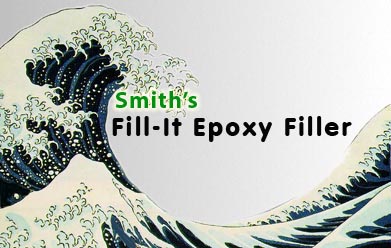
Just when you thought it couldn't get any better:
Smith's Fill-It Epoxy Filler™ now has a new, softer consistency!
Same great long-working-time. Same great hang-in-place performance. Same great ease of sanding or carving. Same great cold-weather-cure. Same great price. When you want the very best: Smith's Fill-It.
Hello. I'm Steve Smith. Thirty-five years ago I invented The Modern Technology That Restores Deteriorated Wood. Fill-It is an essential part of that technology. It works for two reasons: It is about as flexible when cured as the wood itself, and my resins are made largely from the natural resins of wood itself.
Using something that works isn't just a good idea, it's a necessity. We invented it. It's a fifty-fifty mix. It comes with simple directions. You can buy it. You can use it. Call, e-mail or write to 5100 Channel Avenue, Richmond CA 94804-4646 for more information. We can answer your questions.

Smith's Fill-It is a non-sag epoxy filler for restoration of wood.
Easily sanded. Cures overnight.
Smith's Fill-It epoxy filler represents a breakthrough in the technology of filling compounds. Through the use of advanced hydrogen bonding technology, we have produced a high strength, light weight, non-sagging, easily sanded epoxy filler. It consists of an epoxy resin and a curing agent which is derived from natural wood resins, and so is very compatible with wood.
The two components are designed to mix one to one by volume. When mixed they become a gel which may be faired and worked to a feather edge. After one to two hours in moderate weather it begins to harden, and cures overnight. As soon as it does not gum up the paper it may be sanded, and primers or paints applied. It is easily carved or drilled, and screws may be driven into pilot holes without cracking. It has sufficient compressive strength that it maybe be used to fill defects in ferrocement boat hulls, and sufficient flexibility that it is suitable for wooden beams, windows and sills, doors or other parts of wood buildings as well as wood or fiberglass boat hull repair.
This product was invented by a physicist and aerospace engineer (with thirty years experience in the aerospace industry). It was designed to meet the same formulation standards as aerospace materials. It contains an aerospace adhesion-enhancing additive to give it aggressive and tenacious adhesion to wood, cement and a wide variety of materials. It is reinforced with glass fibers for extra tensile strength. In fact, all of the solid fillers or reinforcing additives are chemically engineered glass of one form or another. This gives the best long-term stability and moisture resistance.
In 1992 this product was upgraded, incorporating Smith's new Dual Synergistic Catalyst™ Technology. This gives a longer working time and shorter full cure time. The new technology also ensures an absolutely dependable full chemical cure at temperatures as low as 28°F (-2°C).

In order to ensure good adhesion of Smith's Fill-It epoxy filler to a surface, the first application should be a thin film smeared forcefully against the surface. An additional quantity may then be applied to build up to the required thickness. The uncured material may be tooled smooth and level by placing a clean new piece of clear 4-mil or 6-mil polyethylene sheet over the uncured material and using a squeegee or other tool to smooth the filler through the plastic. Leave the plastic film in place until the filler has cured, when the plastic film may easily be peeled off. In order to ensure adhesion of whatever primer or paint is to be applied next, it is recommended that Smith's Fill-It epoxy filler be sanded before painting.
The two components of Smith's Fill-It epoxy filler are slightly different colors in order to aid in mixing. The mixed color is off-white. Custom colors of Smith's Fill-It may be provided in a sixty gallon minimum order.
MIXING TWO-COMPONENT PRODUCTS
Sophisticated adhesives, sealants and coatings are two-component systems. One part has to be mixed with another part before they are applied. After a while, a chemical reaction takes place, and what is created is a filler, paint or glue with exceptional properties. It is not possible to obtain those properties by taking some simple thing out of a can.
Each of these two parts, whether they are liquids or pastes, consists of very small components called molecules. The manufacturer designed the system so that the individual molecules of each component would react with each other in certain proportions. That is why the instructions say to mix the materials in those proportions.
If the materials are mixed in different proportions, then some molecules of one or another component are left over, scattered among the molecules of both components that did react together. In that case, the material will be softer or weaker than it should be, or will soften in water when it should not. It might be a gooey mess. It is therefore important to mix the components thoroughly, so that everywhere in the mixture the ingredients are in the correct proportions, even down to the individual molecules.
Smith's Fill-It parts A and B are made with different colors to make it easy to thoroughly mix the product. When you can see the streaks of different colors you know you must continue to smear, scrape, fold and mix until the color is uniform. The mixing tools themselves must be scraped occasionally. If mixing a paste on a flat surface, the mixing surface itself must occasionally be scraped off. When mixing liquids in a container, mix thoroughly in one container and then scrape out the entire contents into a second container and mix again.
If there are any soft or gooey spots in the final cured product, that is proof that the material was not thoroughly mixed.
COLOR MATCHING
The color of Smith's Fill-It Epoxy Filler, when cured, is an off-white that will yellow somewhat on exposure. Should it be desired to match the color of wood, this material can easily be changed to match any wood.
Natural wood colors range from yellow to red to tan to brown to grey or black. All these shades can be obtained by various combinations of only four color pigments: white, red, yellow and black. Dry powder pigments which are fully compatible with our products (universal liquid color concentrates are not) are available from Smith & Co.
Smith's Fill-It parts A and B should be mixed together as the product instructions recommend. Then, as each pigment is added, color will develop with mixing. Continue mixing until no further color change is seen with continued mixing. Only then add another color pigment.
Add a small amount of dry white pigment, perhaps a tablespoon or two for a mixed quart. Next, a small amount of red or yellow may be added to approximate the red-yellow balance. Then add a little black to darken to the desired color. Then, try a little more red or yellow if needed. Should the mix be too dark, add some more white to lighten the mix. The total amount of white pigment needed may be comparable to or much more than the total amount of all the other tinting pigments, as a VERY rough guide. Very dark woods will need less white, and will usually have more red than yellow.
SOME EXPERIMENTATION MAY BE NECESSARY.
© copyright 1972 - 2024, Steve Smith,
reprinted with permission
Visit our new website for the Modern view.